Replication of DNA viruses I
what this class is about
steps in DNA replication
-
origins of replication - locations on DNA where
replication always starts
- recognized by sequence
- DNA rep is semiconservative
- each strand in double helix acts as template for synth of new complimentary strand
-
DNA polymerase
- enzyme that makes DNA once the RNA primer is in place
- require a template annd RNA primer (starter)
- synth DNA 5' to 3' direction (new strand complimentary to template)
-
primase
- make primer RNA once on each leading strand template to initiate DNA synthesis
- make RNA primer repeatedly on lagging strand template to initiate okazaki fragment synthesis
- leading strand made continuously
- lagging strand made in small pieces (okazaki fragments)
- other enzymes required: DNA primase, DNA helicase, DNA ligase, topoisomerase
semiconservative DNA replication
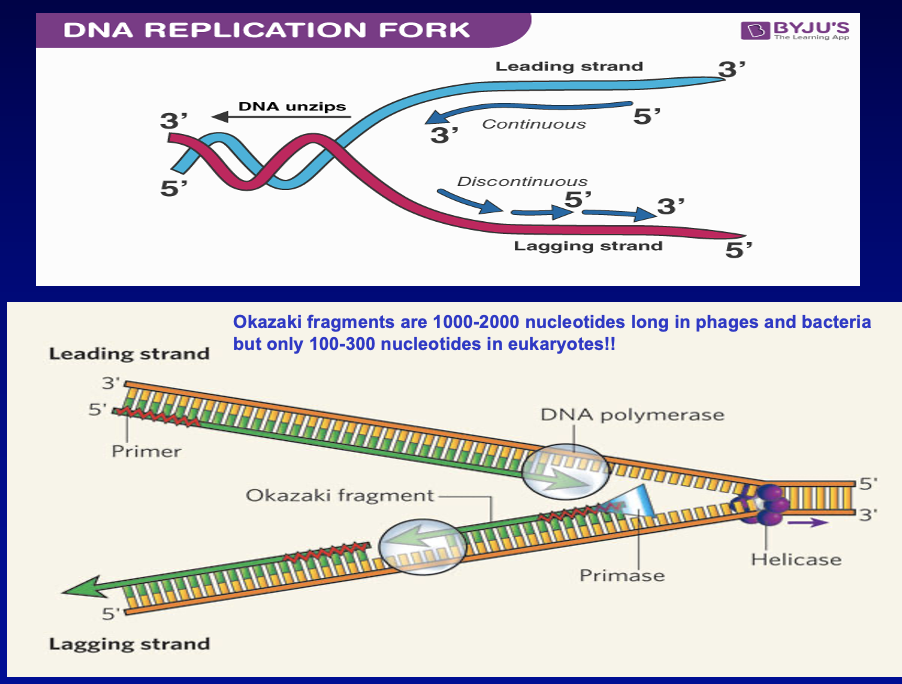
In this model, the two strands of DNA unwind from each other, and each acts as a template for synthesis of a new, complementary strand. This results in two DNA molecules with one original strand and one new strand.
creates fork -> 1 leading and 1 lagging strand
topoisomerase
responsible for preventing DNA from tangling + relieves pressure of supercoiled DNA during replication
- DNA is supercoiled
- prevents supercoiling and tangling
DNA helicase
catalyze disruption of H bonds that hold 2 strands of DS DNA together
summary of DNA replication in proks
- helicase opens DNA at replication fork
- single stranded binding proteins coat DNA around replication fork to prevent rewinding of DNA
- topoisomerase works at the region ahead of replication fork to prevent supercoiling
- primase synth RNA primers complementary to DNA strand (4-16 nucleotides long)
- DNA polymerase III extends the primers (add on 3' end to make bulk of new DNA)
- RNA primers removed + replaced with DNA by DNA polymerase I
- the gaps btw DNA fragments sealed by DNA ligase
Proks: don’t have nucleus or chromosomes, their DNA floats in cytoplasm (bacteria)
Euks: have nucleus and chromosomes
diff btw proks and euks DNA replication
origin of replication
- euks - multiple per chromosome
- proks - 1 per DNA molecule
synth of DNA
- euks - DNA pol alpha, epsilon, etc.
- proks - DNA polymerase III
removal of RNA primers
- euks - RNase H (5'-3' exonuclease)
- proks - DNA polymerase I
replacement of RNA with DNA
- euks - DNA pol
- proks - DNA pol I
rest same between them
helicase
opens DNA at replication fork
- single stranded binding proteins coat DNA around replication fork to prevent rewinding of DNA
topoisomerase
works at the region ahead of replication fork to prevent supercoiling
primase
synth RNA primers complementary to DNA strand (4-16 nucleotides long)
DNA polymerase III
extends the primers (add on 3' end to make bulk of new DNA)
RNA primers removed + replaced with DNA by
DNA polymerase I
The gaps btw DNA fragments sealed by
DNA ligase
steps involved in DNA replication
- recognition of initiation point, origin
- unwinding of DNA
- template DNA
- RNA primer
- chain elongation
- replication forks
- proof reading
- error here during replication may lead to mutation
- DNA pol I and pol III = proof readers of new DNA
- remember RNA replication prone to more mutations bc of mistakes, and DNA mechanisms have proofreading/editing mechanisms that RNA mechanisms dont have
- removal of primer and completion of DNA strand
- joining of fragments
transcription
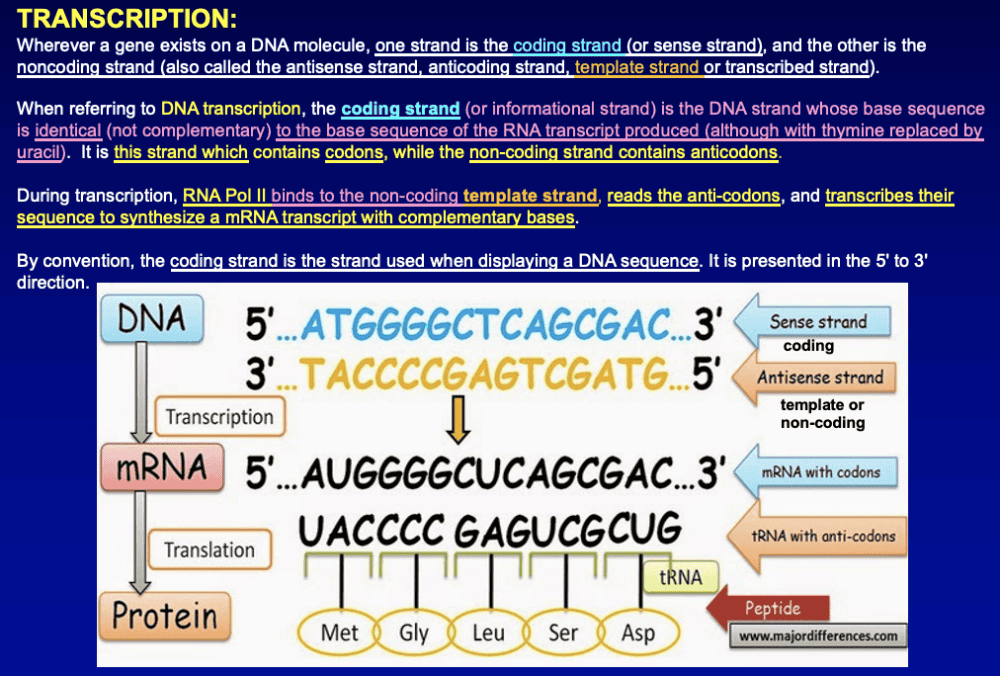
- one strand - coding strand (sense strand)
- other strand - noncoding
strand (antisense strand, template strand)
- contains anticodons
- coding strand is DNA strand whose base sequence is
identical to base sequence of RNA transcript made
(T replaced by U)
- this strand contains codons
- RNA pol II binds noncoding template strand, reads anticodons on it, and transcribes it to make mRNA with complementary bases
- coding strand = strand used when displaying DNA sequence. Presented in 5' to 3' direction
Antisense strand – anticodons contained
- template strand
Sense strand = coding strand -> use to get RNA
- codons contained
mRNA = same as sense strand but T switch for U
Anticodons complimentary to codons obviously
discovery of retroviruses and reversotranscriptase
- david baltimore, nobel prize
- proposed the following classification of viruses based on relationship of viral genome to viral mRNA
- mRNA - identical to coding DNA strand (except T -> U) and complementary to template strand
mRNA configuration
plus (+) configuration
mRNA's complement configuration
minus (-) configuration
+ strand RNA viruses
+ strand RNA viruses = mRNA viruses, since they are mRNA, they can directly translate / make proteins. Do not need any machinery extra to translate
baltimore virus classification
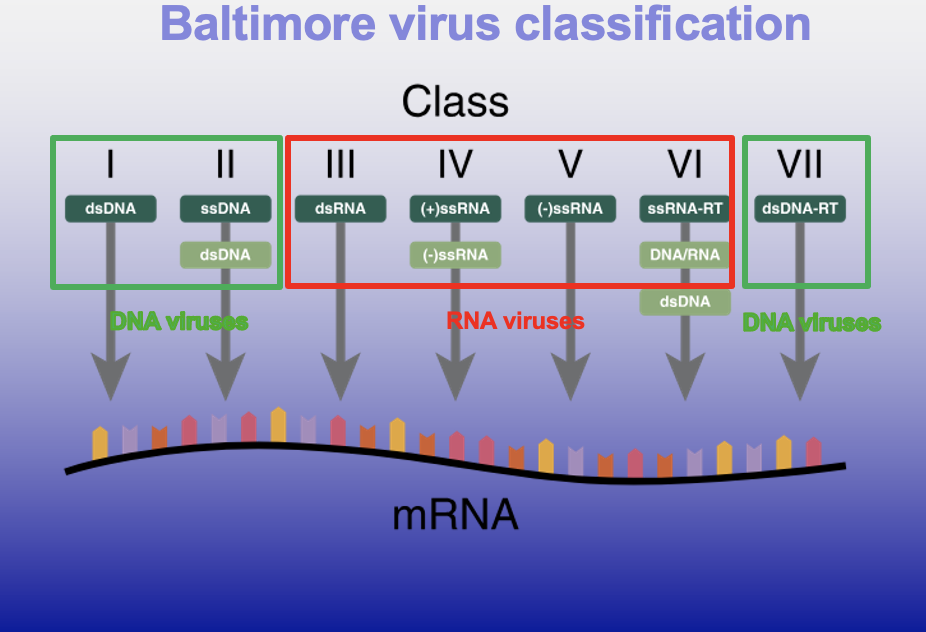
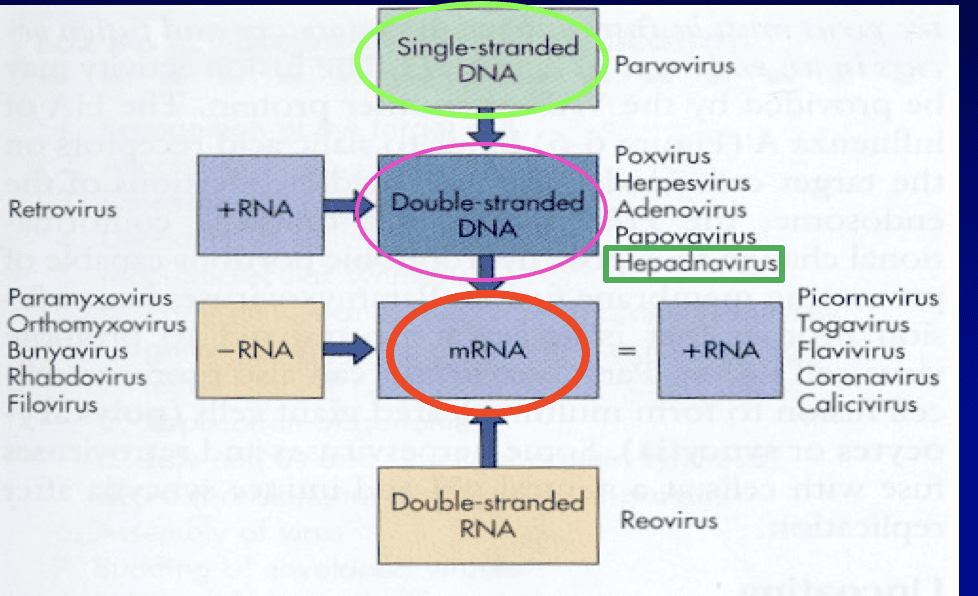
3 groups of DNA viruses
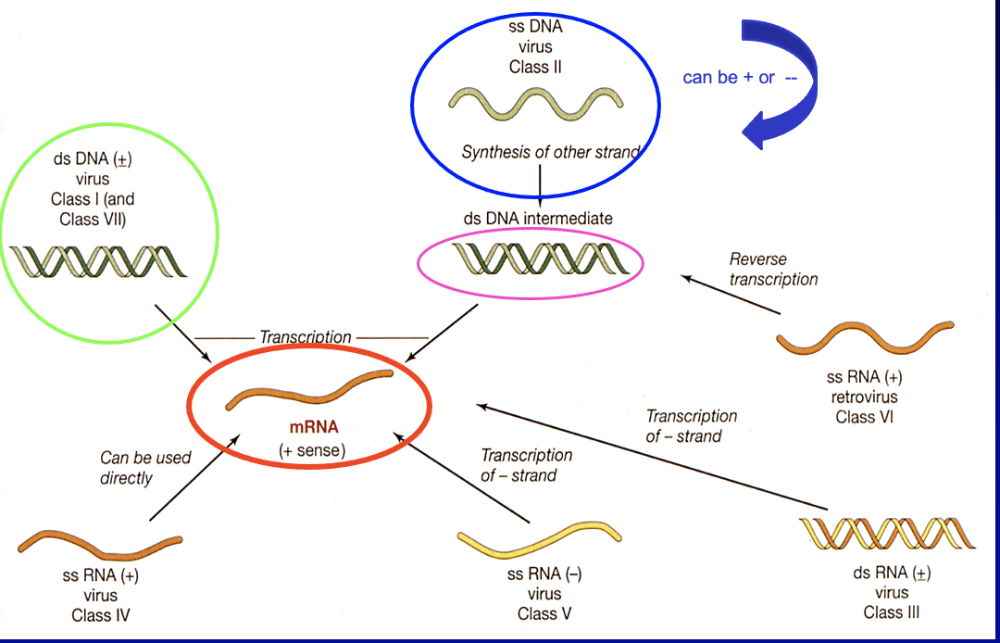
-
ss DNA viruses (class I)
- genome = molecule of single DNA strand
- cannot transcribe unless get double strand of DNA, so it must have a ds DNA intermediate in order to do anything else
- ex: poxviruses
-
ds DNA virus (class II)
- normal DNA molecule of genes
- ex: parvoviruses
-
ds DNA viruses with retrovirus activity (that replicate
through RNA intermediate by reverse transcriptase) - class
VII
- separate classification/group
- ex: hepadnaviruses
DNA viruses infect both proks and euks
prominent DNA viruses - herpesvirus, papillomavirus, and poxvirus
all replicated either by host or virally encoded DNA polymerases
only some ds DNA and all retroviruses use reverse transcriptase
are DNA virus genomes larger or smaller than RNA genomes?
LARGER
bc stability of DNA allows for genomes much larger
large DNA viruses have
ds DNA
small DNA viruses typically have
circular ss or ds DNA
families of DNA viruses
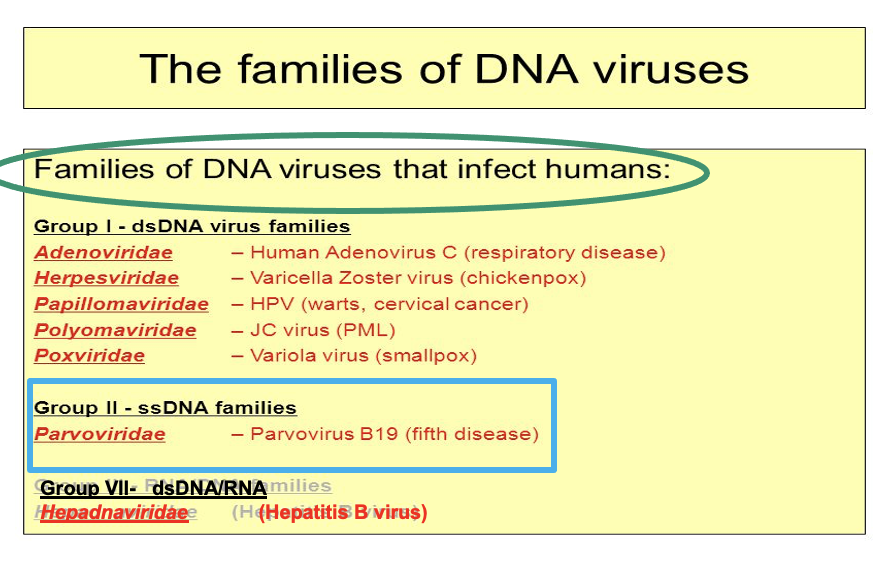
3 groups DNA viruses in humans
- DS
- SS
- DS RNA with retrovirus intermediate step
- today focus on SS DNA families
medically important DNA viruses
-
parvovirus
- no envelope - naked
- small DNA
- icosahedral
- ss linear
-
hepadnavirus
- enveloped
- icosahedral
- DS
-
herpesvirus
- icosahedral
- enveloped
- DS
-
poxvirus
- complex capsid
- enveloped
- DS
poxes are very big viruses
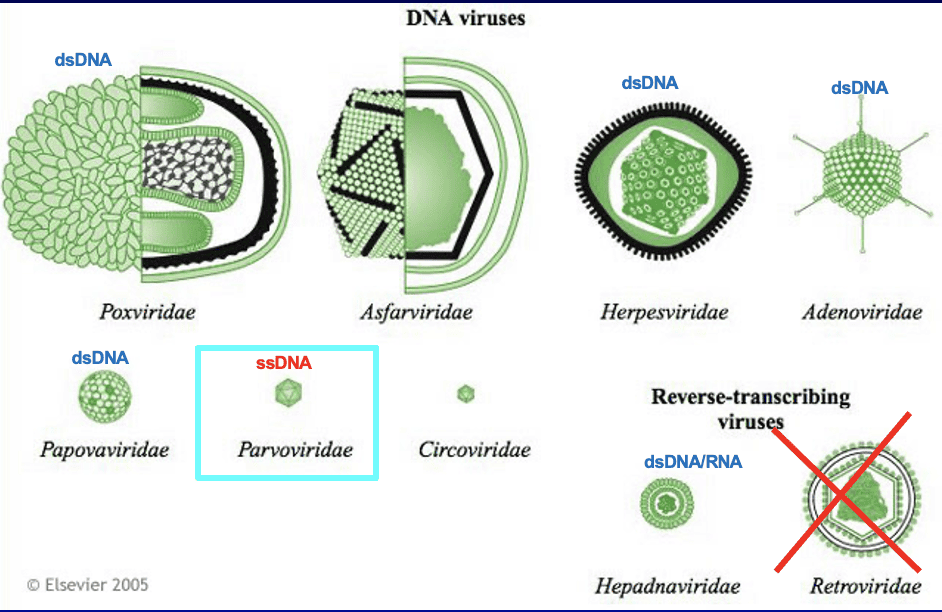
Poxes – very big viruses
Retroviruses – NOT a DNA virus, it is RNA
- remember only 2 groups viruses in humans that are retroviral dependent
We will focus on ssDNA parvovirus
DNA virus gallery
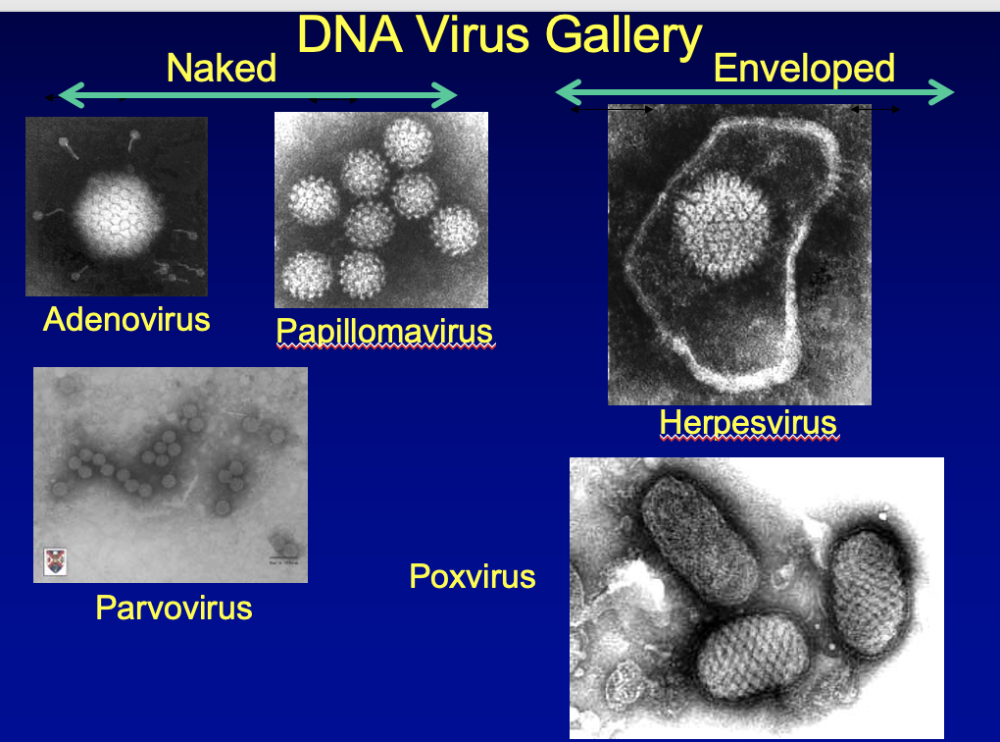
DNA viruses
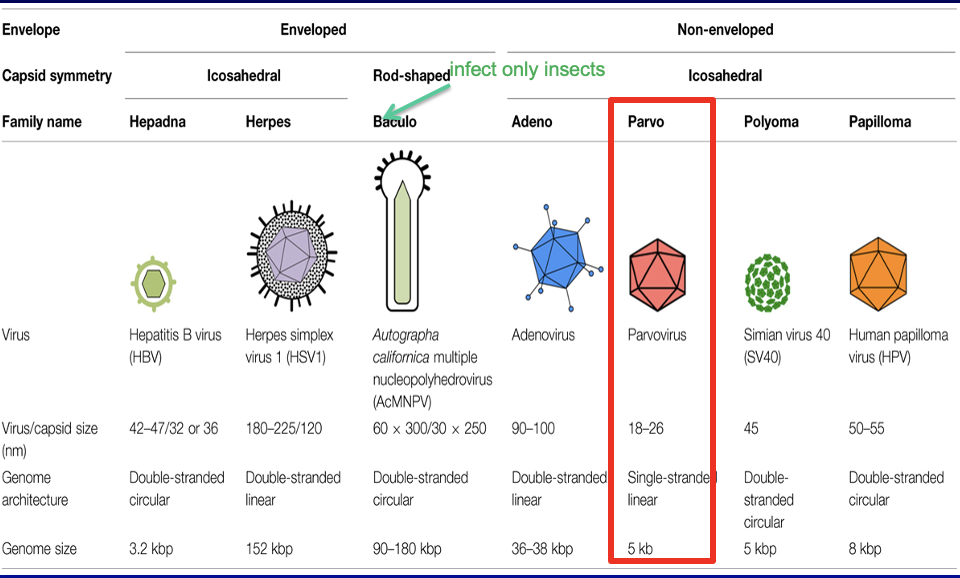
I think may need to know these???
parvovirus - small, naked, ss virus
baltimore classification again
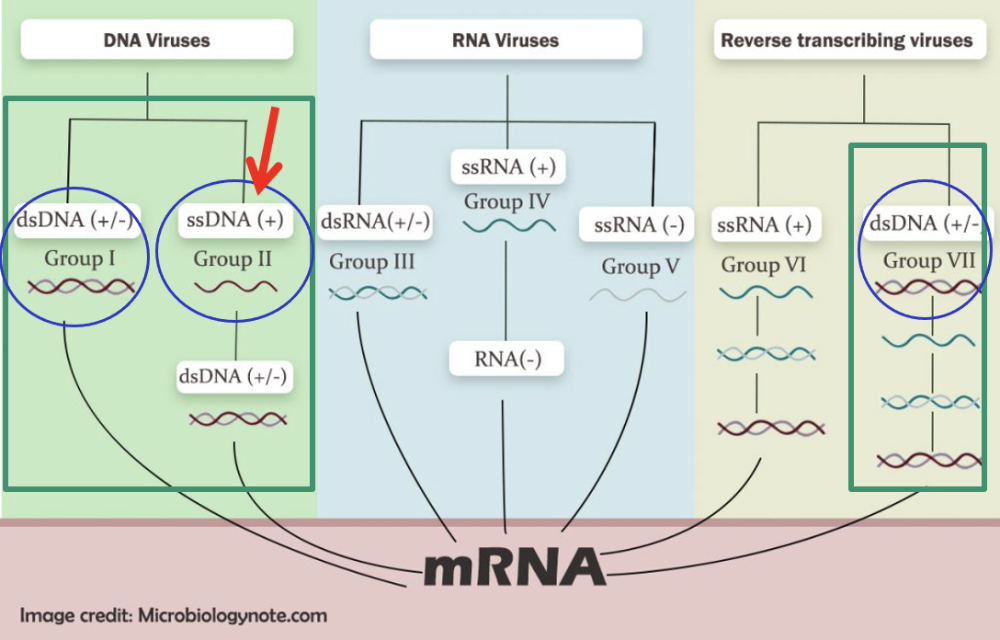
Again, Baltimore classification of viruses
DNA viruses – green
Again, 3 categories of DNA viruses
- Ds DNA thru reverse transcriptase
- Ds DNA
- Ss DNA
overview of diff types of viruses to transcription
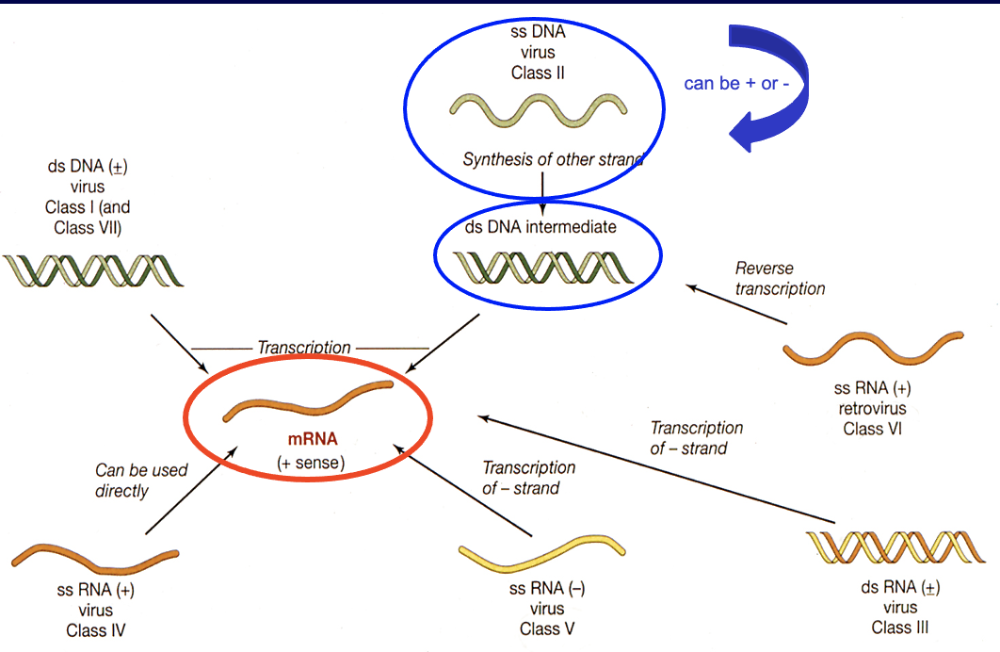
SS DNA must go through ds DNA stage (intermediate) step before doing anything else
for RNA viruses
- transcription of (-) strand necessary to obtain mRNA (+ RNA)
- ds RNA
- ss RNA (-)
- if ss RNA (+) already, can just translate itself to make proteins
class II: ssDNA
- ss DNA information flow
- DNA -> mRNA -> protein
- viral genome - either has same base sequence as mRNA (+ strand DNA) or be complementary to the mRNA (- strand DNA)
-
+ strand DNA -> DNA strand
complementary to viral genome must be manufactured
first -> form DS replicative form (RF)
- can be used to manufacture viral proteins + as template for viral genome copies
-
- strand DNA viruses -> genome can be used
directly to produce mRNA but complementary copy
still needs to be made
- complementary copy to serve as template for viral genome copies
- ss DNA must
be copied into mRNA before proteins can be produced
- RNA can only be made from ds DNA template, no matter what sense the single stranded DNA is -> DNA synthesis must precede mRNA production in replication cycles of these viruses
- single stranded genome is produced by cellular DNA polymerases
flow of info follow normal pathway sort of
viral genome - same base sequence after mRNA (+ strand DNA) OR complementary to mRNA (- strand DNA)
complimentary DNA must be made first before making DS DNA
ssDNA must be copied to mRNA before proteins produced
ssDNA viral genome
either has same base sequence as mRNA ( + strand DNA)
or be complementary to the mRNA ( - strand DNA)
+ strand DNA viruses
same sequence as mRNA
must first create gene complementary to viral genome
= form double stranded replicative form
- -> then use to make viral proteins
- + use as a template for viral genome copies (replication)
- DNA synthesis must occur before mRNA production, because must have double strand DNA in order to make mRNA
- strand DNA viruses
complementary sequence to mRNA
genome can be used directly to make mRNA (bc genome is complementary to mRNA)
- still need to make complementary copy to serve as template for viral genome copies (replication)
- DNA synthesis must occur before mRNA production, because must have double strand DNA in order to make mRNA
complementary DNA must be made before making
double stranded DNA, as a SS DNA virus
single stranded genome is produced by
cellular DNA polymerases
ssDNA viruses
replication:
- euk ssDNA viruses replicate in nucleus
- most ssDNA viruses contain circular genomes replicated via rolling circle replication (RCR)
-
parvoviruses - contain linear ssDNA genomes
replicated via rolling hairpic replication (RHR),
similar to RCR
- either positive or negative sense strand can be packed into capsisd
- almost all ssDNA viruses have + sense genomes, but a few exceptions + peculiarities exist
- parvoviruses may package either + or - sense strand into virions
mRNA transcribed in nucleus - leave nucleus to cytoplasm where ribosomes translate to proteins
-> proteins back to nucleus where assembly of virus occur
-> Rolling hairpin replication – just know it’s the mechanism of linear ssDNA genomes ?
<- not important
replication of ssDNA viruses
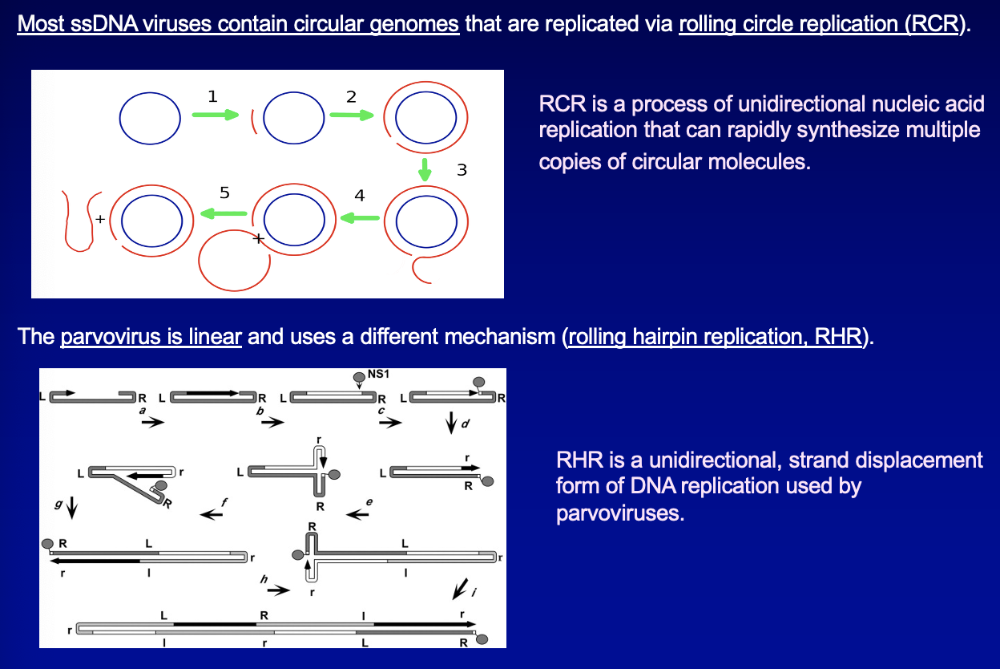
- replicate in nucleus
- -> cytoplasm where ribosomes translate to proteins -> back to nucleus for virus assembly
- most ssDNA viruses have
circular genome - replicated via rolling
circle replication (RCR)
- process of unidirectional nucleic acid replication that can rapidly synth multiple copies of circular molecules
- parvovirus - linear
- use rolling hairpin replication (RHR)
- unidirectional, strand displacement form of DNA replication used by parvoviruses
for us to know the diff, not very important
what is the replication mechanism of SS DNA genomes?
circular genome (usually) -> replicate via rolling circle replication (RCR)
Linear ones (like parvovirus) - rolling hairpin replication (RHR)
(almost) all single stranded DNA viruses have what genome?
+ sense
circular
SS DNA viruses TRANSCRIPTION
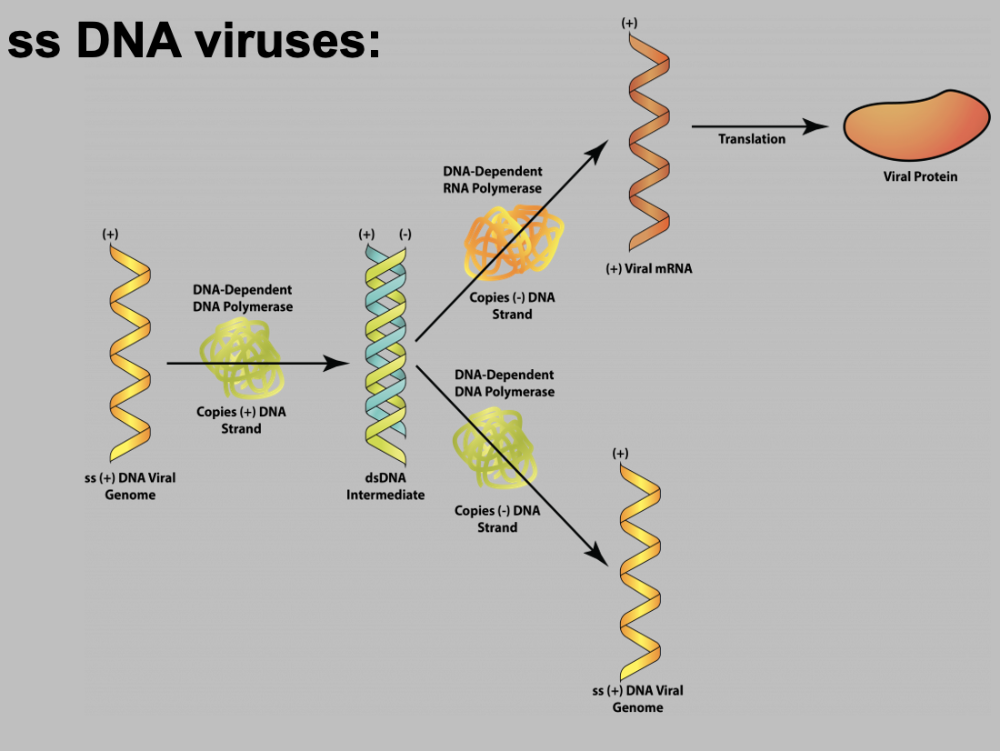
-
transcription
- ssDNA viruses have same manner of transcription as DS DNA viruses
- BUT: single
stranded -> must first make self into a double
stranded form by host DNA
polymerase upon entering host cell
- must be made into ds form (can only transcript from ds DNA) by host DNA pol in order to make mRNA
- mRNA is then synth from the double stranded form
-
the double stranded form of ssDNA viruses may be produced
either directly after entry into a cell or as a consequence of
replication of the viral genome
- = can either use to make more ss DNA (populate its genome) OR can use to make viral mRNA
- euk ssDNA viruses replicated in the nucleus
ssDNA virus replication cont.
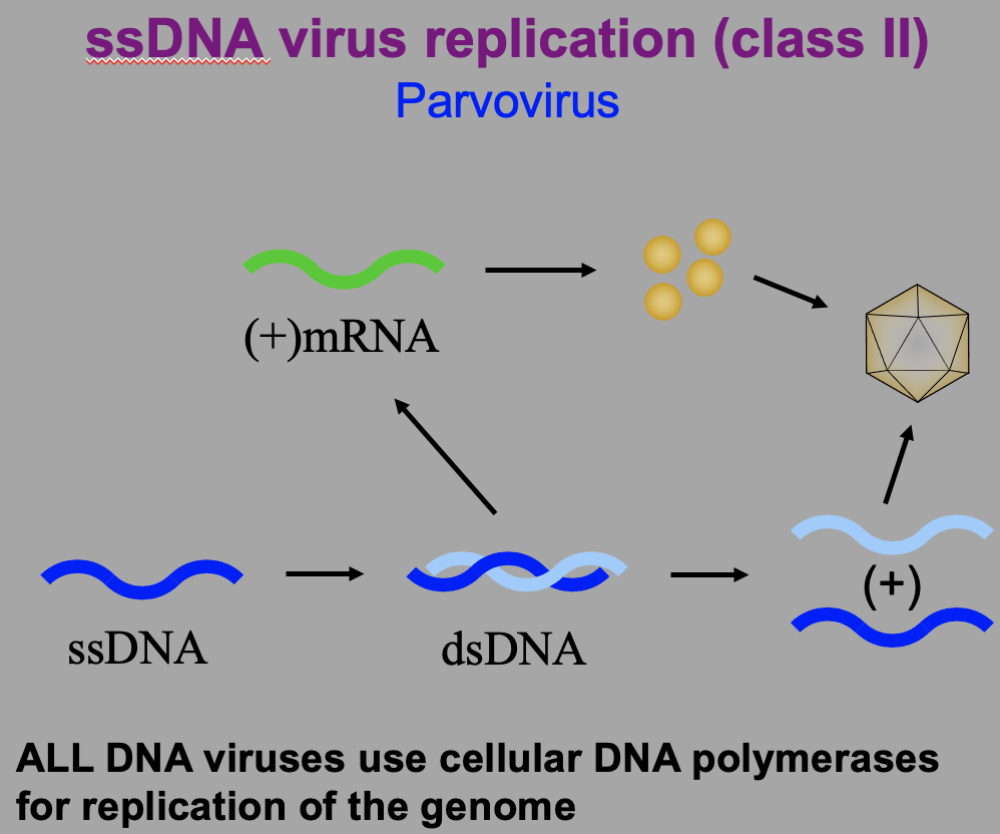
ALL DNA VIRUSES USE CELLULAR DNA POLYMERASE FOR REPLICATION OF THE GENOME
human B19 parvovirus replication cycle
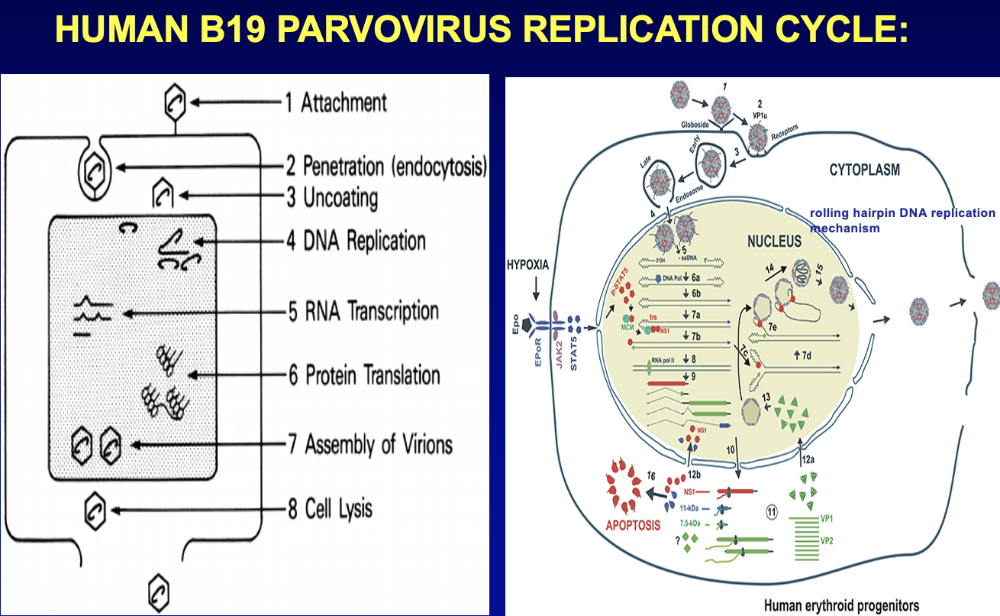
Right pic
- virus enter thru receptor
- go to nucleus -> to perform everything need to replicate DNA -> Transcription
- mRNA out nucleus into cytoplasm to translate
- back in nucleus to form viral particle
- then leave cell
Mistake in left pic – mRNA supposed to go outside gray box to do protein translation
parvovirus life cycle
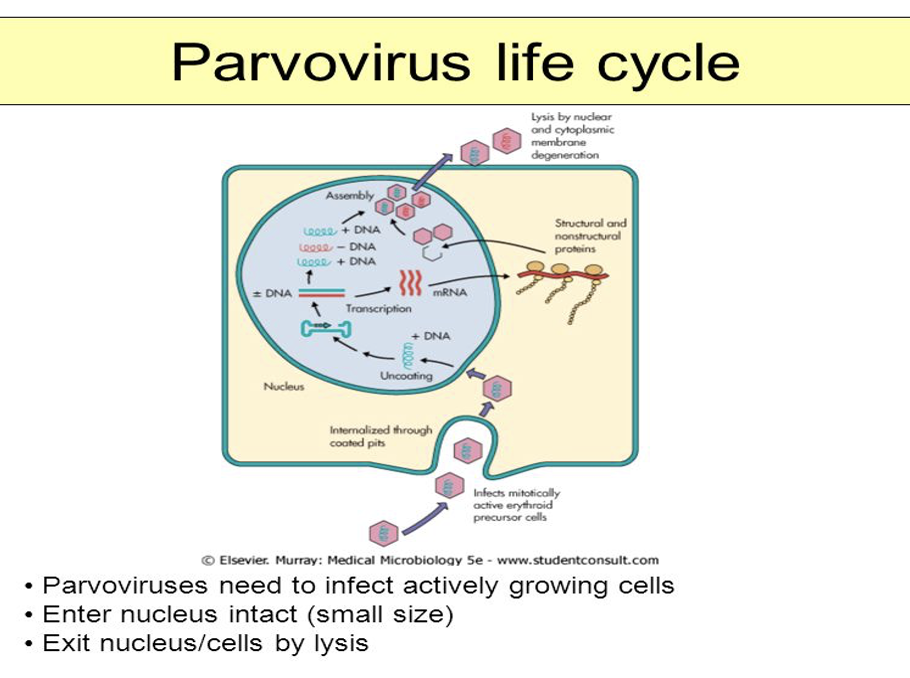
GENOME. Interestingly enough, Parvoviridae is the only family of DNA viruses that infect humans that is single stranded. The DNA strand packaged in the virion can be either negative or positive sense, in approximately equal proportions.
Replication takes place in the nucleus of dividing cells. The single-stranded DNA genome forms an intermediate double-stranded form, which replicates to form progeny-positive and -negative single-stranded DNA. Positive and negative strands are packaged separately in viral capsids in equal numbers.
Internalization of both + and – DNA
Genome – only family of DNA viruses infecting humans that is SS
- replication in nucleus
Leave, packaged separately in viral capsids
Parvovirus must infect actively growing cells
what is the only ss DNA virus infecting humans?
parvovirus
second deadly dog disease
Canine parvovirus
Vaccine important/mandatory for dogs
Remember virus is naked – so is very resistant to environmental factors, temp, etc.
parvovirus B19 fifth disease: the human disease from parvovirus
Human disease from parvovirus
There are 4 that we do not have today
rash on face
lace-like rash on extremities